
New
Results Change Higgs Mass Estimate
Model Virus Mutes the
Effects of HIV
New Results Change Higgs Mass Estimate
BY LYNN YARRIS
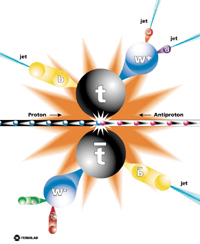 |
|
| Collision! In this artist’s representation of a particle collision, a proton and antiproton collide at high energy to produce top and antitop quarks and other particles. |
In a case of the plot thickening as the mystery unfolds, the Higgs boson has just gotten heavier, even though the subatomic particle has yet to be found. In a letter to the scientific journal Nature, published in the June 10, 2004 issue, an international collaboration of scientists working at the Tevatron accelerator of the Fermi National Accelerator Laboratory (Fermilab) report the most precise measurements yet for the mass of the top quark — a subatomic particle that has been found — something which requires an upward revision for the long-postulated but still undetected Higgs boson.
“Since the top quark mass we are reporting is a bit higher than previously measured, it means the most likely value of the Higgs mass is also higher,” says Ron Madaras, a physicist with Berkeley Lab’s Physics Division, who heads the local participation in the D-Zero experiment at the Tevatron. “The most likely Higgs mass has now been increased from 96 to 117 GeV/c2, which means it’s probably beyond the sensitivity of current experiments, but very likely to be found in future experiments at the Large Hadron Collider being built at CERN.” (GeV/c2 is a common particle physics unit of mass, with a proton measuring about 1 GeV/c2.)
The Higgs boson has been called the missing link in the Standard Model of Particles and Fields, the
theory that’s been used to explain fundamental physics since
the 1970s. Prior to 1995, the top quark was also missing, but then
the experimental teams working at the Tevatron’s two large detector
systems, D-Zero and CDF, were able to independently discover it. Scientists
believe that the Higgs boson, named for Scottish physicist Peter Higgs
who first theorized its existence in 1964, is responsible for particle
mass — the amount of matter in a particle. According to the
theory, a particle acquires mass through its interaction with the
Higgs field, which is believed to pervade all of space and has been
compared to a molasses that sticks to any particle rolling through
it. The Higgs field would be carried by Higgs bosons, just as the
electromagnetic field is carried by photons.
“In the Standard Model, the Higgs boson mass is correlated with
top quark mass,” says Madaras, “so an improved measurement
of the top quark mass gives more information about the possible value
of the Higgs boson mass.”
According to the Standard Model, at the beginning of the universe there were six different types of quarks. Top quarks exist only for an instant before decaying into a bottom quark and a W boson, which means those created at the birth of the universe are long gone. However, at Fermilab’s Tevatron, the most powerful collider in the world, the collision between billions of protons and antiprotons will yield the occasional top quark. Despite their brief appearance, these top quarks can be detected and characterized by the D-Zero and CDF experiments.
In announcing the D-Zero results, experiment co-spokesperson John Womersley said, “An analysis technique that allows us to extract more information from each top quark event that occurred in our detector has yielded a greatly improved precision of ±5.3 GeV/c2 in the top mass measurement, compared with previous measurements. The new measurement is comparable to the precision of all previous top quark mass measurements put together. When this new result is combined with all other measurements from both the D-Zero and CDF experiments, the new world average for the top mass becomes 178.0 ± 4.3 GeV/c2.”
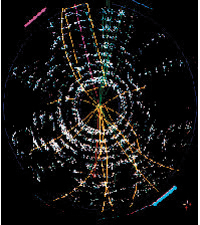 |
|
| New measurements of top quark mass at Fermilab have revised estimates for the mass of the Higgs boson. | |
The D-Zero detector system consists of a central tracking detector array, a hermetic calorimeter for measuring energy, and a large solid angle muon detector system. Berkeley Lab designed and built the two electromagnetic end-cap calorimeters and also the initial vertex detector, the innermost component of the tracking system. Tracking detectors supplement calorimeters by measuring particle trajectories. Only when trajectory and energy measurements are combined can scientists identify and characterize particles.
While raising the central value for top quark mass appears to diminish the possibility that the Higgs boson could be discovered at the Tevatron, it does open a wider door for new discoveries in supersymmetry, an extension of the Standard Model that unites particles of force and matter through the existence of superpartners, sometimes referred to as sparticles. Supersymmetry, also known as SUSY, seeks to fill gaps left by the Standard Model
“The current mass limits or bounds that exclude supersymmetric particles are very sensitive to the top quark mass,” says Madaras. “Since the top quark mass is now higher, these limits or bounds are not as severe, which increases the chance of seeing supersymmetric particles at the Tevatron.”
Scientists from nearly 40 U.S. universities and 40 foreign institutions contributed to the data analysis reported in the letter to Nature from the D-Zero experimental group. In addition to Madaras, Berkeley Lab coauthors of the letter were Mark Strovink, Al Clark, Tom Trippe, and Daniel Whiteson.
Model Virus Mutes the Effects of HIV
BY LYNN YARRIS
In a biological version of fighting fire with fire, researchers at Berkeley Lab and UC Berkeley are designing a genetically modified form of the HIV virus to prevent HIV infections from developing into AIDS. While their model of an HIV parasite, called crHIV-1 (for conditionally replicating HIV-1) is yet to be synthesized, it has performed well in computer simulations.
“At this time we are nowhere near an AIDS therapy, but our model does show great promise in simulations and we’re very excited about this line of research,” says Adam Arkin, a member of the Department of Computational and Theoretical Biology in the Physical Biosciences Division and a UC Berkeley professor in Bioengineering, who is leading this research. Collaborating with him are David Schaffer, with UC Berkeley’s Department of Chemical Engineering, and Leor Weinberger, a UC Berkeley graduate student who was instrumental in formulating the initial concept and subsequent development of this crHIV-1 model.
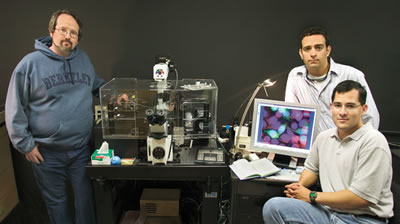 |
| From left: Adam Arkin, David Schaffer and Leor Weinberger used synthetic biology techniques to create a computer model of a virus that would hamper the ability of HIV to develop into AIDS. |
Many in the public still equate HIV (Human Immunodeficency Virus) with AIDS (Aquired Immune Deficiency Syndrome). Persons infected with the HIV parasite gradually lose their ability to fight off disease and infection. AIDS is declared only when the victim’s immune system becomes depleted beyond a critical level and opportunistic infections and other diseases arise as a result.
The characteristics of an HIV infection, specifically the presence of long-lived, latently infected cell populations, make it unlikely that it can be completely eradicated through the use of antiviral drugs. An alternative approach is to manage the infection so that it is no longer life-threatening.
“The idea is to reduce the virus population and thereby delay or even prevent the onset of AIDS,” says Arkin. “This could be done by creating a parasite of HIV, crHIV, that would suppress production of the HIV parasite by converting latently infected cells into a pseudolatent state.”
When an individual is first infected with HIV, there’s a period before the body’s immune system kicks in, usually about two months, during which the HIV parasite rapidly reproduces and spreads to other cells. The parasite’s primary target is a type of cell in the immune system called a CD4 T lymphocyte. Following this initial unchecked replication, the virus population stabilizes at the HIV set point. A victim’s set point level is inversely correlated with the time to AIDS onset. For a typical HIV positive patient, the set point is maintained for about 10 years. When the number of uninfected CD4 T cells drops below a critical threshold, the HIV parasite population increases and the HIV infection develops into AIDS.
“Recent evidence suggests that reducing the HIV set point below some absolute value may not be necessary,” says Arkin. “Rather, the relative extent of the HIV set point reduction in a patient appears to be a significant predictor of patient health and immune recovery.”
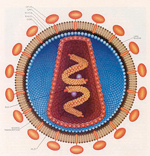 |
|
| The HIV-1 virus is not likely to be completely eradicated through antiviral drugs, but Berkeley researchers are looking to control it with a modified version of itself. | |
Currently, the only effective means of reducing the HIV set point
is called HAART (for highly active anti-retroviral therapy). HAART
drugs are highly toxic, expensive and can be quickly overcome by resistant
HIV mutants. To find something better, Arkin, Schaffer and Weinberger
turned to synthetic biology. One of the hottest new fields in the
life sciences, the goal of synthetic biology is to design and construct
novel organisms and biologically-inspired systems that can solve problems
natural biological systems cannot.
Other researchers have done preliminary in vitro observations
of crHIV-1 viruses, but Arkin, Schaffer and Weinberger are the first to explore what would be needed for a crHIV-1 virus to infect an HIV virus in an organism, then proliferate and persist enough to reduce the HIV set point. To design their version of a crHIV-1 therapy, they worked with a widely accepted mathematical model of HIV in vivo, called the Basic Model of HIV-1. Criteria for their crHIV-1 virus were kept relatively simple.
Explains Schaffer, “Our design introduces only two new parameters. The first is the ability of the parasitic virus to suppress HIV production. We’ve designed antiviral cargos that target the host cell functions that HIV needs to replicate, rather than HIV viral functions that can be rapidly evolved around. The second parameter is the ability of the parasite virus to propagate in parallel with HIV. If our parasite suppresses HIV too much in its host cell, then it can’t propagate and spread to other cells to prevent further HIV infection.”
Schaffer says that when computational modeling of both parameters is complete, this therapy virus will be created in the laboratory and in vitro studies will begin. One of the critical questions to be resolved is the potential for crHIV-1 to be transmitted from one individual to another. This could be a problem or a benefit. As he and his collegues explained in an earlier paper on this research, which was published in the September 2003 issue of the Journal of Virology, the spread of crHIV-1 through the population might to act to mitigate the spread of HIV and AIDS.
Robinson Appointed Director of the Engineering Division
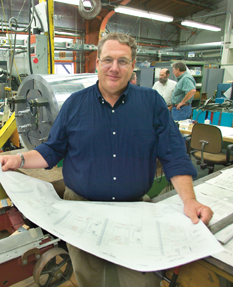 |
|
| Kem Robinson |
On June 1, Director Charles Shank announced the full-time appointment of Kem E. Robinson as director of the Engineering Division. Robinson has been serving as acting head of the division since September, when Jim Triplett stepped down. Robinson will also continue to serve as the Laboratory’s project management officer, a position he has held since 2001.
During an all-hands meeting with the Engineering staff, Shank praised Robinson for having successfully “implemented many of the recommendations made by the Laboratory’s Engineering Task Force, including refocusing the strategic direction toward strong partnerships with the scientific divisions.”
Robinson joined the Laboratory in 1999 as the deputy for General Sciences Projects. In 2000 he was named principal division deputy of the Accelerator and Fusion Research Division. His main area of research is experimental free-electron laser (FEL) development, and he worked on the first operational storage ring FEL in Orsay, France.
Before joining Berkeley Lab, Robinson spent more than 10 years with STI Optronics, Inc., a Bellevue, Washington R&D firm. There he was responsible for the development of insertion devices used for synchrotron radiation centers and free-electron lasers, as well as for compact mass spectrometer magnets designed for use by NASA on a Mars rover.
Robinson received his B.S. degree in physics from Brigham Young University in 1978 and his Ph.D. from Stanford University in 1984.
“We at Berkeley Lab are particularly fortunate to have someone of Dr. Robinson’s breadth of experience in project management and technology development as the leader of our Engineering programs,” Shank said. “I greatly appreciate his contributions and look forward to his leadership going into the future.”
Lab Staffers Help Feed the Fans at weekend Giants Games
BY D. LYN HUNTER
Linda Mendonza and Shelley Caras, who both work for the Lab’s Facilities Division, love hanging out at the ballpark. So they decided to get weekend jobs there. And theirs is a most important occupation, for what is a baseball game without food?
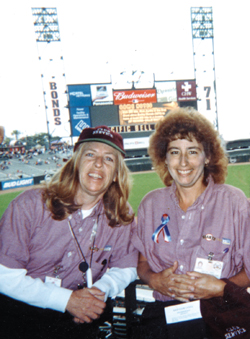 |
|
| Linda Mendonza (left) and Shelley Caras at a Giants game. | |
On weekends, the two work at the Giants’ SBC Park as wait staff, taking orders for hot dogs, peanuts, garlic fries and other ballgame staples from people in the club-level section. The orders are sent electronically to the food stands, and “runners” deliver the goods.“I was trying to save money to buy a house,” explains Caras, who drives trucks for the Transportation Department. “So I thought this would be a fun way to make some extra bucks.”
“The flexibility is what I like,” adds Mendonza. “I can work whenever I want to.”
There are other perks besides convenient schedules and improved cash flow, they say. While working, they get to witness history in the making. Both were present when Barry Bonds matched and broke the 660-home-run record. They’ve also been there for crucial play-off and World Series games, and have brushed elbows with such greats as Willie Mays and Willie McCovey.
While working, they have to keep one eye on their customers, and one on the action on the field, for safety reasons.
“We’ve had foul balls hit up into the stands very close to our heads,” says Caras. “And we have to quickly get out of the way when fans stampede to try and grab those balls.”
Occasionally, they get rude comments from folks in their section. “One guy told me, ‘I didn’t buy a ticket to watch you,’” recounts Mendonza, a five-year veteran. “But it’s rare. Most of the fans are very polite.”
“We’ve made a lot of friends over the years,” says Caras, who started waiting on fans at Candlestick 15 years ago. “One couple started coming in as boyfriend and girlfriend, then they got married, and now they bring their kids to the park.”
During the week, the women can be found working hard at the Lab. Mendonza runs the customer counter at the supply store in Building 78, filling orders for everything from bolts and paint brushes to letterhead stationary.
Caras delivers all kinds of goods, both on- and offsite, from office supplies to magnets, autoclaves, and other scientific machinery. At five-foot-one, she garners some surprised looks when she jumps out of the 18-wheel semi truck she often drives.
Caras and Mendonza are the only women who work in their respective departments, but they hold their own in their male-dominated professions, providing a crucial service to the Lab.
“Without people like Linda and me,” says Caras jokingly of their dispensing and delivery of goods, “people here couldn’t even blow their noses!”
VENUS Breaks Records at 28 Gigahertz
BY PAUL PREUSS
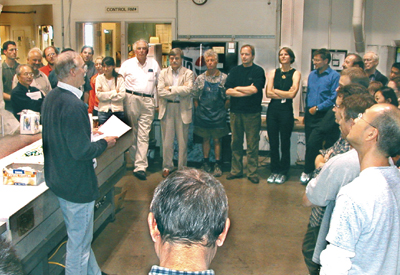 |
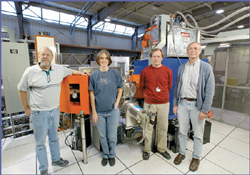 |
|
| Claude
Lyneis, director of the 88-Inch Cyclotron, told the crowd in Building
88 that “VENUS is the highest-field operating ion source
in the world, years ahead of the competition.” P hoto by Jim Morel, 88-Inch Cyclotron operations supervisor |
From
left: Steve Abbot, main mechanical engineer; Daniela Leitner,
head of ion-source development at the 88-Inch Cyclotron; Matthaeus
Leitner, former VENUS project manager and project physicist; and
Claude Lyneis, director of the 88-Inch Cyclotron (with the actual
VENUS ion source in the background). P hoto by Roy Kaltschmidt, TEID |
A May 21 call from ion-source development head Daniela Leitner to Claude Lyneis, director of the 88-Inch Cyclotron, informed him that VENUS had confined a plasma at 28 gigahertz (28 billion cycles per second). “I didn’t melt it,” she said, “so now we can have a party.”
Guests from the Nuclear Science Division and other divisions gathered a week later to celebrate in Building 88’s spruced-up high bay. Among them were Deputy Laboratory Director Pier Oddone, NSD Director James Symons, and Accelerator and Fusion Research Division Director Bill Barletta.
Lyneis told the crowd that “VENUS is the highest-field operating ion source in the world, years ahead of the competition.” He named the many engineers and scientists who helped create VENUS, crediting Charles Shank with launching development through a 1996 Laboratory Directed Research and Development grant.
Symons called VENUS the “culmination of work Claude has been pursuing since 1983” — a string of record-setting electron-cyclotron resonance sources for which Lyneis is a world-recognized leader. Leitner anticipates “steady progress” toward achieving the highly ionized plasmas, from hydrogen to uranium, that the superconducting VENUS was designed for.
The extraordinary ion source will serve research at the 88-Inch Cyclotron and function as a prototype for the DOE’s proposed Rare Isotope Accelerator.
For more about VENUS visit http://www.lbl.gov/Science-Articles/ Archive/NSD-VENUS.html.
Scientists Try to Explain Weekend Smog
BY DAN KROTZ
Ever notice that weekends are smoggier than weekdays? Probably not, but Robert Harley has. He’s one of a growing number of scientists who are studying why smog levels spike on weekends.
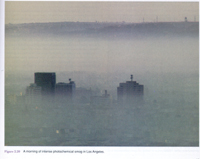 |
|
| Los Angeles under its infamous smog blanket. | |
“Smog levels always increase in the summer when it’s warmer and there is more sunlight,” says Harley, a scientist with Berkeley Lab’s Environmental Energy Technologies Division (EETD) and UC Berkeley’s Department of Civil and Environmental Engineering. “But buried in this annual cycle is variability at other time scales, such as the day of the week.”
Harley and his colleagues, Linsey Marr of UC Berkeley and Laurent Vuilleumier and Nancy Brown of EETD, aren’t the first scientists to report the weekend effect. It’s been noticed in urban areas throughout the world. But Marr and Harley were the first to analyze 20 years of air-monitoring data, culled from over 100 sites throughout California, and determine that the weekend effect has spread inland. Moreover, they found that this perplexing phenomenon has become more pervasive in California in recent years, spreading from coastal urban areas such as Los Angeles and San Francisco to Sacramento and the northern San Joaquin Valley.
“Weekday-weekend ozone differences have increased over the last 20 years in California,” says Harley.
Smog is formed when pollutants such as nitrogen oxides and volatile organic compounds (VOCs) are emitted into the lower atmosphere and react with sunlight to create ozone. At high enough concentrations, ground-level ozone can cause lung and respiratory problems. In California, the main sources of these smog-forming pollutants are cars, which emit both nitrogen oxides and VOCs (primarily as unburned fuel from tailpipes), and diesel trucks, which emit mainly nitrogen oxides (as well as other pollutants such as soot).
Precisely how this combination of car and diesel truck emissions contributes to the weekend effect remains unclear, but there are several theories. One is based on the fact that both cars and trucks are on the road during the week, emitting nitrogen oxides. But on the weekend, when work-related diesel truck traffic diminishes, there’s an approximately 40 percent reduction in nitrogen oxide emissions. This reduction actually causes smog levels to increase, most likely because nitrogen oxides can suppress ozone formation under certain conditions.
“It’s counterintuitive, but reducing emissions from diesel trucks may lead to higher ozone levels on weekends,” says Harley. “This could mean, at least in urban areas, that making small reductions in nitrogen oxides may cause increases in ozone formation. But larger reductions, such as up to 90 percent less nitrogen oxide emissions, would probably result in a reduction in smog.”
According to another theory, the weekend effect stems from a shift
in peak driving hours, from morning and late afternoon commute hours
on weekdays to noon on the weekends. At this hour, the sun is brightest
and conditions are optimal for ozone formation.
“On the weekend, even though the number of cars on the road
is almost the same, you get a shift in the timing of emissions, which
can contribute to more smog,” says Harley.
However, Harley and his colleagues found that this change in driving times is much less important than the decrease in diesel truck traffic in explaining weekday-weekend differences in air pollution. Ultimately, he believes that weekly cycles in emissions and air quality provide a practical way to test scientists’ understanding of how the atmosphere responds to changes in pollution-causing activities.
JGI Sequencing Helps Unravel Sudden Oak Death
BY DAVID GILBERT
Thanks to the DNA sequence produced by the Joint Genome Institute (JGI) in collaboration with the Virginia Bioinformatics Institute (VBI), researchers are getting closer to thwarting two related plant diseases — one causing “Sudden Oak Death” (SOD) and another responsible for a devastating soybean disease. The projects received nearly $4 million in support from the U.S. Department of Agriculture (USDA), the National Science Foundation (NSF), and the U.S. Department of Energy.
“The ability to use large-scale multi-agency collaborations to rapidly characterize such economically important microorganisms is the cornerstone of the resource that we have established at the Joint Genome Institute,” said Ray Orbach, director of the DOE Office of Science, which funds operations of the JGI. “The genome sequence information will enable the identification of cellular processes that can be targeted for novel detection systems and for safe and effective means of chemical or biological control.”
The Joint Genome Institute, established in 1997, combines the sequencing resources of Lawrence Berkeley, Lawrence Livermore, and Los Alamos national laboratories.
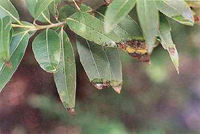 |
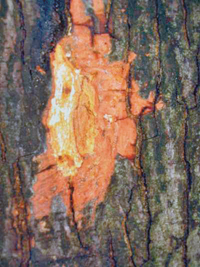 |
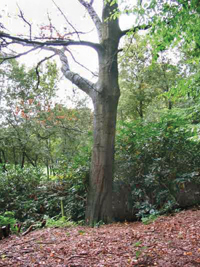 |
| California
bay laurel (Umbellularia californica) |
Canker
on northern red oak (Quercus rubra) |
Northern red oak |
“The genome sequences for these two Phytophthora [pronounced Fy-TOFF-thor-uh] species provide a framework for understanding how these plant pathogens cause disease and what can be done to control them,” says Dr. Joseph Jen, of the USDA.
Sudden Oak Death was first reported in 1995, but the agent responsible for the disease was discovered by University of California scientists in 2000. The pathogen is known to be present in 13 California counties and also in Southern Oregon. It has also been detected at 125 nurseries across the nation, elevating concerns to an all-time high. Symptoms vary depending on the host. Infected oak trees exhibit bleeding cankers on the trunk, and often succumb to the disease or to secondary infections as they are weakened by P. ramorum. In foliar hosts — such as California bay laurel, camellia and rhododendron — the pathogen reveals its presence through leaf blight and twig dieback.
The economic impact of Phytophthora sojae has been far-reaching. The U.S. produces almost half the world’s soybeans. Losses attributed to P. sojae infestation exceeded $1 billion in 2003.
“Phytophthora species attack a wide variety of plants, including agricultural crops as well as trees and shrubs of native ecosystems,” says Mary Clutter of the NSF. The projects to sequence the genomes of Phytophthora sojae, which attacks primarily soybeans, and Phytophthora ramorum, the pathogen causing Sudden Oak Death, Clutter says, “will contribute great value in combating these devastating diseases.”
The aptly named genus Phytophthora derives its moniker from the Greek words for “plant destroyer.” Part of a fungus-like group of organisms known as oomycetes, or water molds, they are relatives of such aquatic algae as diatoms and kelp. The pathogens survive as thick-walled spores that can persist in soil for years. The infamous mid-19th century Irish potato famine was caused by P. infestans, one of the 59 recognized Phytophthora species.
“The sequencing of the P. ramorum genome represents the fastest tracking from identification of a new plant pathogen to the completion of its genome,” says Brett Tyler of VBI. Tyler’s research group provided a genetic map of the P. sojae genome from which JGI was able to assemble the raw DNA sequence data. “Sequencing P. sojae will enable the past 15 years of advances in understanding the genetics of Phytophthora pathogens to be rapidly transferred to P. ramorum, in effect serving as the Rosetta Stone for sudden oak death.
“The genome sequence of P. ramorum will help researchers to track the spread of SOD much more accurately by enabling them to develop more detailed genetic fingerprints,” says Tyler. “Based on experience with developing fingerprints for other organisms, including humans, researchers know what kinds of sequences to look for in the genome sequence — for example, simple sequence repeats. Accurate tracking of P. ramorum will help determine the routes of spread, and to answer the question more accurately as to whether P. ramorum can spread from nursery plants into the forest.”
According to JGI Director Eddy Rubin, more than 30,000 genes have been identified in these pathogens. “The USDA is sponsoring additional applied research at the JGI that will exploit the sequence information for the development of rapid, more effective field detection systems for SOD,” he says. “This second-generation detection method relies on distinguishing traces of DNA sequences, or aptamers, to home in on substances released by the pathogen during infection.”
A public biotechnology company, Affymetrix, headquartered in Santa Clara, Calif., has utilized the publicly available sequence generated by JGI and VBI to develop a GeneChip® Microarray, containing probes to detect DNA transcripts of Phytophthora sojae for soybean gene expression research. The power of Affymetrix technology to package the entire expressed genomes of multiple organisms
on a single array — host and pathogens in this case — affords scientists the unique ability to ask new biological questions. For example, gene expression in both soybean and Phytophthora can be measured during the pathogenic process. This would help identify genes from both organisms specifically involved in pathogenic mechanisms and host defense.
Phytophthora ramorum, with a genome size of some 65 million nucleic acid bases, or letters of the genetic code, was iteratively sequenced by JGI seven times to assure the quality of the data. Phytophthora sojae, at approximately 95 megabases, was sequenced nine times over.
More information on SOD can be found at the California Oak Mortality Task Force (COMTF) website: http://www.suddenoakdeath.org.
Berkeley Lab Does BIO2004
BY DAVID GILBERT
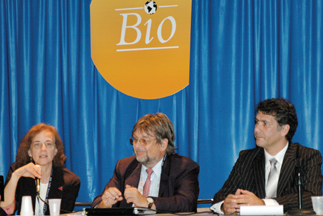 |
|
| Cheryl Fragiadakis (left) shares a panel with Horst Domdey, CEO of BioM AG (Germany) and Frederic Allemand, executive director of Genopol Ebry (France). |
Thomas Wolfe was once again proven wrong. You can go home again. This time, it was the biotech industry’s biggest road show, BIO2004, coming home to roost in San Francisco, biotech’s birthplace. Monday through Wednesday, Moscone Center was filled to the rafters with every permutation of biotechnology business player (not to mention a formidable phalanx of San Francisco police to keep would-be protestors at bay). At least a dozen Berkeley Lab researchers and technology managers joined the fray to show off their wares.
The Biotechnology Industry Organization (BIO) is the largest biotech industry advocacy group in the world, boasting some 1,000 biotechnology companies, academic institutions, state biotechnology centers, and related organizations in all 50 U.S. states and 33 other nations. BIO members’ activities span research and development in a broad range of health care, agricultural, industrial, and environmental biotechnology products. BIO2004 was the organization’s largest conference in its 11-year history, surpassing 18,000 participants and filling downtown San Francisco hotels to the brim. This year’s event attracted representatives from such diverse ports as Algeria, Armenia, the Ivory Coast, Kazakhstan, and Yemen.
Berkeley Lab’s Technology Transfer office mounted an active campaign to get the word out about technologies available for licensing. On Monday, Cheryl Fragiadakis, head of Technology Transfer, appeared on a panel on “Using the Biotechnology Incubator as a Mechanism for Technology Transfer.” She explained Berkeley Lab’s strategy to break through the frenzy of the conference and find appropriate partners.
“This year we are highlighting our oncology portfolio,” she said. “In the past, when we went to BIO, we tried to feature a broad spectrum of technologies related to molecular biology, medical imaging, bioinformatics.” Fragiadakis said that the previous approach, while reinforcing the multidisciplinary nature of the Laboratory, diluted the message. “This year we decided to focus on the oncology area, where we thought would generate considerable interest.” These technologies included breast cancer therapies and detection systems, cellular assays for high-throughput screening, and antibodies for monitoring DNA double-strand break repair.
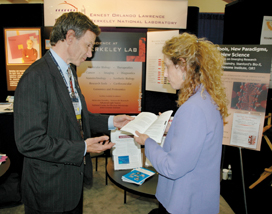 |
|
| Pam Seidenman, head of Technology Transfer at Berkeley Lab (right), discusses Lab technologies with Fred Dorey, the founding president of the Bay Area Bioscience Center (now BayBio). | |
Pam Seidenman, Tech Transfer’s marketing head, received a positive response through BIO’s Business Forum, a one-on-one partnering component of the conference. She linked up with biotech giants such as Wyeth, Johnson & Johnson, and Pfizer, as well as smaller enterprises such as the South San Francisco’s Sunesis. She also pitched these technologies to the broader industry and investment community and organized a session to feature local academic user facilities and resources ripe for collaboration. Seidenman enlisted Eddy Rubin, director of the Joint Genome Institute and head of Berkeley Lab’s Genomics Division, to chair the panel, which also featured Mark Alper of Materials Sciences.
Berkeley Lab’s Terry Hazen, head of the Center for Environmental Biotechnology, was featured in a session on environmental science.
Spinach, or the Search for the Secret of Life as We Know It
BY PAUL PREUSS
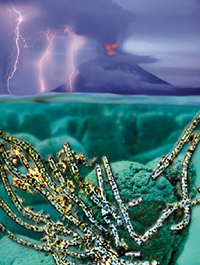 |
|
| Some
photosynthesizing bacteria found a way to survive the harsh environment
of primitive Earth by secreting tough films. Accumulating mats
of these bacteria formed stony pillars called stromatolites, among
Earth’s oldest fossils — and they still grow today
in places like Western Australia. |
Earth, four billion years ago: a high-pressure carbon dioxide atmosphere, an acidic ocean with no dissolved oxygen, a surface blasted with unfiltered ultraviolet light. For a billion years the first single-celled organisms protected themselves by hiding under rocks or secreting tough films. Able to fix carbon through reactions powered by UV light and catalyzed by iron and sulfur, they lived on a diet of methane, hydrogen and bicarbonates.
By 2.5 billion years ago, bacteria similar to modern cyanobacteria had stumbled upon a way to break water into oxygen molecules and hydrogen ions (protons), freeing electrons and releasing energy to power their growth. Oxygen began to accumulate in the atmosphere.
At the heart of the process was the manganese complex — a tiny
molecular structure incorporating four manganese ions, one calcium
ion, and a number of oxygen atoms. (Ions are atoms with net electrical
charge, in this case positive charges.)
“The manganese complex produced all the oxygen that today’s
life forms depend on,” says Vittal Yachandra of the Physical
Biosciences Division, who heads the Lab’s ongoing research program
into the unique biological mechanism called the oxygen-evolving complex
(OEC). “It changed the course of evolution and made life as
we know it possible.”
Gourmet spinach
The oxygen-evolving complex employed by primitive cyanobacteria was so efficient it is still used by plants today — including that long-time favorite of the photosynthesis researcher, spinach. “We’re spinach experts, real gourmets,” Yachandra remarks with a smile. “We buy 10 or 12 bunches at a time.”
The OEC functions even after spinach leaves have been pulverized into juice. The sequential steps of the process can be triggered by precisely timed flashes of laser light. After each step the solution is frozen to stabilize the electronic state.
Yachandra and his colleagues, including nominally retired but still active OEC researcher Kenneth Sauer, study photosynthetic structures and processes in these spinach Popsicles by many techniques, including an array of x-ray spectrometries. They were the first to establish that the manganese and calcium ions are all part of the same complex, held together by bridges of oxygen atoms.
The complex is housed in an assembly of proteins known as photosystem II (PSII), which uses energy captured from light to split water into oxygen molecules and hydrogen ions, freeing electrons in the process. The freed electrons are transported to another protein assembly, photosystem I, and then through a series of biochemical reactions known as the Calvin cycle — named for Berkeley Lab’s Nobel-Prize-winning chemist Melvin Calvin — which fix carbon and energize growth.
So complex is PSII that protein crystallographers were unable to image its structure until 2001, despite decades of trying. The European team that first successfully determined the structure, headed by Horst-Tobias Witt and Wolfram Saenger, have provided Yachandra and his colleagues with crystals.
“We can now do x-ray spectroscopy on PSII crystals themselves,”
says Yachandra. By fitting their very high-resolution models of the
manganese complex from spectroscopy into the electron-density maps
produced by x-ray crystallography, “we’ll get the manganese
complex structure at very high resolution. These are exciting times.”
Photosynthetic timescapes
“It’s fascinating that there’s been no improvement in the system in over 2.5 billion years,” says Ken Sauer. “Photosynthetic bacteria used the same complex. Where did it come from?”
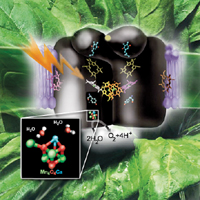 |
|
| Photosystem II uses solar energy to break water into oxygen plus hydrogen ions, meanwhile freeing electrons to drive other reactions. At the heart of the oxygen-evolving complex used by plants such as spinach is a cluster of manganese and calcium ions and the oxygen atoms that bridge them (after Fufezan and Sutliff, Science). | |
Sauer and Yachandra believe the answer may lie in the rocks. They examined manganese oxide minerals with x-ray spectroscopy and found that many contain crystalline structures corresponding to possible configurations of the PSII manganese cluster. Such minerals are found near deep-sea vents and on the ocean floor, and in soils, rock varnishes and weathered outcrops. Primitive bacteria could have adapted the machinery in the rocks to help oxidize water, eventually stumbling upon a way to encode genes for manganese oxide structures in their own genomes.
Understanding the way the oxygen-evolving complex works will have practical applications as well. “You can isolate PSII from a bunch of spinach, put it in water, turn on a light, and get oxygen,” says Yachandra. “We still don’t know how to do that on the lab bench using synthetic catalysts.”
Oxygen molecules are only one product of the OEC, which also yields hydrogen ions and electrons. If a way could be found to modify the OEC to produce molecular hydrogen, not just bare protons, “we could use this in the new hydrogen-power economy,” Yachandra says.
Recently an even-higher-resolution structure of PSII from x-ray crystallography was published in the March 19, 2004 issue of Science, confirming the structure of the manganese complex previously determined by Yachandra and his colleagues. Although “we still don’t know how to copy nature,” says Sauer, “we now seem closer to a full understanding of PSII than at any time in the last 15 years.”
For more about the oxygen-evolving complex, see next month’s edition of Berkeley Lab’s online Science Beat.
Berkeley Lab View
Published every two weeks by the Communications Department for the employees and retirees of Berkeley Lab.
Reid Edwards, Public Affairs Department head
Ron Kolb, Communications Department head
EDITOR
Monica Friedlander, 495-2248,
msfriedlander@lbl.gov
Associate EDITOR
Lyn Hunter, 486-4698 lhunter@lbl.gov
STAFF WRITERS
Dan Krotz, 486-4019
Paul Preuss, 486-6249
Lynn Yarris, 486-5375
CONTRIBUTING WRITERS
Jon Bashor, 486-5849
Allan Chen, 486-4210 David Gilbert, 925-296-5643
FLEA MARKET
486-5771, fleamarket@lbl.gov
Design & Illustration
Caitlin Youngquist, 486-4020
TEID Creative Services
Communications Department
MS 65, One Cyclotron Road, Berkeley CA 94720
(510) 486-5771
Fax: (510) 486-6641
Berkeley Lab is managed by the University of California for the U.S. Department of Energy.
Online Version
The full text and photographs of each edition of The View, as well as the Currents
archive going back to 1994, are published online on the Berkeley Lab website
under “Publications” in the A-Z Index. The site allows users to
do searches of past articles.
Flea Market
- AUTOS & SUPPLIES
‘03 TOYOTA SIENNA minivan, blue, 16K mi, exc cond, ac, am/fm/cass/cd, all pwr, under warranty for additional 20K mi, $24K, Ilham, X7001, 368-4765
‘00 VW BEETLE GLS, $9,800, 50K mi, 5 sp, 30 MPG reg gas, luxury pkg, exc cond, photos at www.jstokstad.com/beetle, Bob, X4451, 548-2429
‘00 DODGE GRAND CARAVAN minivan, 7 passenger, 3.3L, V6, 46K mi, pwr win/locks, privacy glass, exc cond, new brakes & tires, no accidents, all records avail, $10,500, Marc, X6926, 526-1071
‘99 BMW 328i, 5 spd manual, 49K mi, 1 owner, ex cond, silver, delux inter,17” alloy wheels, moonrf, air, pwr win & seat, 12 spk, Harmon-Kardon stereo, $21,000, Peter, 642-8087
‘92 HONDA ACCORD EX, 4 dr, 170K mi, well maint, sunrf, ac, am/fm/tape,5 spd manual, Doug, 525-9275
‘90 HONDA CIVIC wagon, 4 WD, 135K mi, 1 owner & 1 mechanic, $5,700 recent upgrades, great mech cond, minor cosmetic blemishes, $4,995 John, X7279, 528-2723
HOUSING
ALAMEDA, 2 bdrm/1 bth apt in charming Victorian bldg, hardwd flrs, high ceilings, walking dist to Park street shops & shopping center, quiet building, no pets/smok, avail immediately, $1,250 mo, Janice, 895-3584
ALBANY, beautiful 3 bdrm/2 bth home, completely remodeled w/ new kitchen, b&b fp, soaking tub, around the corner from Solano Ave restaurants, shops, theaters, no pets, asking $3,500/mo, Colleen, 525-8892
BERKELEY HILLS, 1 bdrm lower unit in duplex, 3 bridge view, priv 600 sq ft + 400 sq ft deck, nr campus, combined liv rm/kitchen w/ fp, shared laundry, $1,500/mo, 1st + $1,500 dep, single occupant only, Amy, X5044, 540-5605
BERKELEY HILLS, 1 bdrm/1 bth fully furn apt in brown shingle home in North Berkeley hills, nr Kensington border, priv patio, spacious liv rm, marble bthrm, carpet, lots of built-in natural woodwork, spacious bdrm w/ king size bed, fully equip kitchen, free cable TV, walk to shopping & pub trans, nr UCB, $1,090/mo +$600 dep, no pets/smok, avail immediately, Ivankash@hotmail.com, Helga, 524-8308
BERKELEY, charming 2-story family home in quiet residential North Berkeley neighbrhd, close to schools, shops, Monterey Mkt, track & swim pool, BART, 3+ bdrms, 2 full bths, laundry rm, new central heating, hardwd & tile flrs, fp, deck, $2,500, 1-yr lease, Reg, 849-0649 or 219-0649
BERKELEY, residential community of UC & Lab staff and grad students, Hearst Commons, Hearst nr University, close to pub trans, BART & bike path, res parking incl in rent, indoor/outdoor studio townhouse w/ decks, some furn can be provided, hardwd flrs, skylights, dw, ac, intercom, security, $825, Ian, 220-2051
BERKELEY HILLS studio, nr Lab/restaurants & shops/Tilden Park, La Loma-Glendale Park, 12x12 rm w/ priv ent through lge deck w/ outdoor furn, priv bthrm, white carpet, kitchenette pantry, microwave, new fridge, furn/TV avail, shared DSL/TV cable, no smoking, avail 4/15, $670/mo, 25% of util, sec dep, 1-yr lease pref, pianist in building, occaisional arts salons, 845-4624
CENTRAL BERKELEY, nice furn rms, kitchen, laundry, PC, DSL, hardwd flrs, brkfst, walk to campus/shops, $800/mo incl everything, (925) 595-2608, ashleyulmer@sbcglobal.net
KENSINGTON, furn rm avail for vis scholar during summer 6/15 – 8/15, kitchen access, $500/mo, Ruth, 526-2007
KENSINGTON, fully furn 3 bdrm home, view, quiet setting, 1 cat, avail for vis scientist during summer and/or fall terms, $1,600/mo + sec dep, Ruth, 526-2007, 526-6730
PIEDMONT, lge 11x17 furn bdrm w/ priv bthrm, avail after 5/25 in nice, quiet, scenic neighbrhd, full access to kitchen, laundry rm & 1 space in garage, $575, 1-yr lease, Weilun, 486-4079
s
VALLEJO, 5 bdrm home, very spacious, quiet neighborhood, lge backyrd, 25 min from Lab, no pets, $1,900 mo/$1,900 dep, avail now, Dean, (707) 373-3023
MISC ITEMS FOR SALE
BED, Ikea, wood Dalselv & spring air mat, full size, 2 yrs old, exc cond, must pick up, Catalin, X7376, (925) 730-5279
BED, Little Tykes Race Car, holds standard size twin mat, spoiler is a bookcase, front trunk is a toy chest, 104x48, exc cond, retails for $499, asking $150; bike, Huffy 22”, $100/bo, Michelle, X6783, magachis@lbl.gov
CHIPPER/Shredder, heavy duty, 10 hp, exc cond, $200, Jerry, X5316
LASER Rangefinder, Bushnell Yardage Pro 800, non-compact style, soft case, neck strap, lens caps, manual, perfect working cond, VG appearance, $120, Eric, X7183, 237-9909
LENS Elmar, Leitz Focomat Ic darkroom enlarger, works great, very sharp, $95; 3x3 white kitchen table, steel pedestal base,4 small grey, steelcase office chairs, all for $95, Peter, X5321, 849-3198
MOTOR, outboard, lightweight 16#, air cooled, 2.7HP, cruise & carry, 2 cycle, great cond, $100/bo, Bob (925) 376-2211
PICTURE, Nuclei and Particles, autographed by Emilio Segre, published in 1965, good cond, make offer, Julie, 232-6919, cell, 367-5524
SKIS, Dynastar Outland T-160, 5x3, made in France, used for 2 seasons only, $45, Salomon XSCREM700, 5’, made in Austria, $35, both for $60, Nanyang, 334-9241
SMARTMEDIA CARDS Memorex, new but open, 1 each, 128/64/32MB for $20/10/5 or $30 for all 3, Joe, X6414
SOFA & LOVESEAT SET, dark color, b/o; 5-piece king size bdrm set, b/o; file cabinet, steel, blk, 4 drawers, $10; 12x36 swimming pool package w/ filter, $20/bo; refrig, Kenmore, beige, b/o; oven, 30 in, built in, double, b/o; cooktop, 30 in, stainless steel, b/o; Kim, X4523
SOFA, caned back & chair, PowerMac & printer, computer desk, chest of drawers, Andria, 704-1441
SPEAKERS, 100 watt, Pioneer CS-99A, $60/pair; 80 watt Pioneer CS-88A, $50/pair Larry, X5262, (707) 447-1348
FREE
INK CANON CARTRIDGES, BCI-11 black, BCI-11 color, and BC-11e which can be used as a BC-11 in color, Lynne, X5587
NORFOLK PINE TREE, 6 ft tall, in wooden pot, attractive, in good cond, John, X7189, 524-7376
LOST & FOUND
FOUND: Girl’s coat in Bldg. 66 auditorium last mo, Joe, X5816
LOST: A’s baseball cap, Ken, X7739
VACATION
LAKE TAHOE house, 3 bdrm/2.5 bth, fenced yard, quiet sunny location, great views of water & mountains, $195/night,
2 night min, Bob, (925) 376-2211
PARIS, FRANCE, nr Eiffel Tower, furn, eleg & sunny 2 bdrm/1 bth apt, avail yr-round by wk/mo, close to food stores, restaurants, car rental, pub trans/shops, 848-1830
Flea Market Policy
Ads are accepted only from Berkeley Lab employees, retirees, and onsite DOE personnel. Only items of your own personal property may be offered for sale.
Submissions must include name, affiliation, extension, and home phone. Ads must be submitted in writing
(e-mail: fleamarket@lbl.gov, fax: X6641), or mailed/delivered to Bldg. 65.
Ads run one issue only unless resubmitted, and are repeated only as space permits. Ads must be submitted in writing and be no more than 50 words in length. The submission deadline for the April 30 issue is Friday, April 23.
People, AWARDS & HONORS
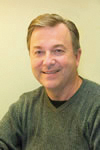 |
|
| Dan Lunsford |
Lab Welcomes New Security Chief
Dan Lunsford, previously the emergency services manager for the City of San Leandro, has replaced Don Bell as group leader for Security and Emergency Operations at Berkeley Lab. Bell retired on May 28 after 12 years of service. Lunsford holds a B.S. in business administration and an M.S. in public administration from San Diego State and is certified by the International Association of Emergency Management.
 |
|
| Neil Bartlett | |
Bartlett Honored by French Chemistry Foundation
Neil Bartlett, a retired principal investigator with the Lab’s Chemical Sciences Division, was recently awarded the grand prize from La Fondation de la Maison de la Chimie (the Foundation of the House of Chemistry). The award recognizes Bartlett’s life work on novel high-oxidation-state materials. He will be handed the award at a special ceremony this July in Paris.
 |
|
| Alexis Bell |
Russian Academy Honors Alexis Bell
Chemical Sciences Division scientist Alexis Bell recently became the first person in the field of chemistry and chemical engineering to receive an honorary professorship from the Siberian branch of the Russian Academy of Sciences. He also received an honorary doctoral degree from the organization. The honor was conferred for his “outstanding contributions to science and international cooperation.” Bell presented two lectures during his visit to Russia to accept the award.
Ramsey Receives DOE Security Award
Dwayne Ramsey, ITSD’s liaison to the Department of Energy and the University of California and the Lab’s acting manager of the Computer Protection Program, was one of two recipients of the 2004 Charlene Douglass Memorial Award presented at DOE’s Annual Cyber Security Group Training Conference in Kansas City. The award recognizes people who have “significantly contributed to information security activities within the DOE complex.” Ramsey was nominated for his efforts to significantly strengthen cyber security throughout the DOE national laboratory community by fostering a sense of cooperation and collaboration.
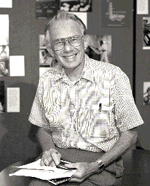 |
|
| Art Rosenfeld | |
Rosenfeld Wins ‘Flex Your Power’ Award
Art Rosenfeld, who in 1974 formed the Center for Building Science at Berkeley Lab and for 20 years developed a variety of innovative energy-efficient products and programs here, has received the Lifetime Achievement in Energy Efficiency Award from the Flex Your Power energy conservation group. The Center, which he headed until 1994, developed innovative energy-efficient products and programs, including the DOE-2 computer program for the design and energy analysis of buildings. In 2000 Rosenfeld was appointed to the California Energy Commission. He is also the cofounder of the American Council for an Energy Efficiency Economy and of UC’s Institute for Energy Efficiency.